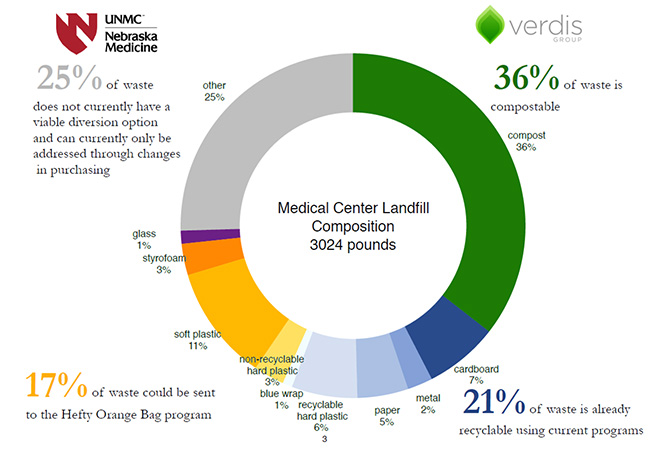 |
Operating a major medical center requires lots of materials, many of which end up in the landfill. As the med center works to achieve the Net Zero Waste goal (minimum 90% of all non-regulated waste diverted from landfill/incineration), it’s important to know what specific items are going to the landfill. The med center then can use this information to strategically guide sustainabiliy efforts.
Last year, we conducted a waste audit of seven campus locations that capture 80% of the material sent to the landfill. Over the course of two months, over 3,000 pounds of trash were collected, sorted and measured. Major findings include the following:
- 36% of landfill waste is compostable.
- The largest portion of the compostable materials is paper towels.
- 21% of our landfill waste is recyclable using current programs (including cardboard, metal, paper and hard plastic).
- If all compostable and recyclable material were successfully diverted, the med center would have a 68% diversion rate.
- This would be the highest diversion rate of any medical center in the country.
We need your help to improve and stop recyclables from going to the landfill. The single most effective thing we can do today is to recycle materials, like pop cans or cardboard, that we can and should be recycling already. Wondering what materials can be recycled at the med center? Check out the LiveGreen Recycling page for details.
You may have heard stories about cities struggling to find markets for recyclable materials, in part due to changes China has made. While that is true, Omaha is still recycling. In order to ensure our items are recycled, we need to do two things:
- Put the item in the correct bin. This means no trash in the recycling bin as well as no cardboard in the paper bin, etc.
- Remove food/liquid prior to recycling. Items don’t need to be super clean, but remember: This process isn’t completely automated. People are involved. If too many items are too gross to process or put people at risk, the entire load is sent to the landfill.
What else can you do? Whenever possible, reduce. Using less is always the best first choice, and that counts towards our goal too. You can bring your own silverware rather than using single-use plasticware, use electronic versions rather than printing and so on.
Your actions matter. Even a seemingly small change can help improve health — our mission!

I urge everyone to think about what they put in the trash. Can it be recycled? I see a lot of plastic bottles in the waste cans.
Does the campus participate in the Hefty Orange Bag Program? If so, where can we find those receptacles?
Bethany,
We currently do not participate in that program. It's something we are looking into, but the logistics of collecting it would be challenging right now. More importantly, because the orange bag contents are incinerated for energy (either in a factory or as diesel) they do not apply for our Zero Waste goal which requires diverting away from the landfill or incineration. I agree that soft plastics need to be addressed, but putting those chemicals up into the atmosphere does not align with our health-centered mission. That said, we are hopeful this process will result in a recycling facility being built nearby and are still looking at ways we can recycle it. In the meantime, we need to find ways to reduce it. I know it's not possible to eliminate it, as plastic is an important component in sterility of supplies, but there are things we can do to reduce its use. If you have ideas on how we can do this, we'd love to hear them!
Thank you,
Melanie